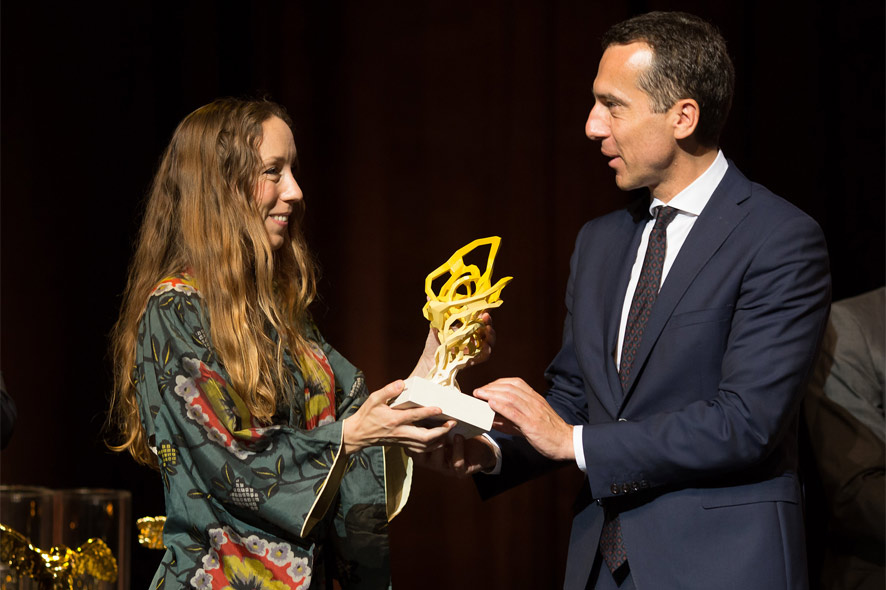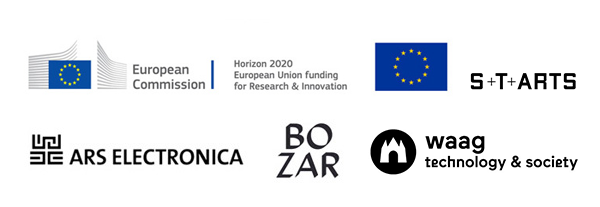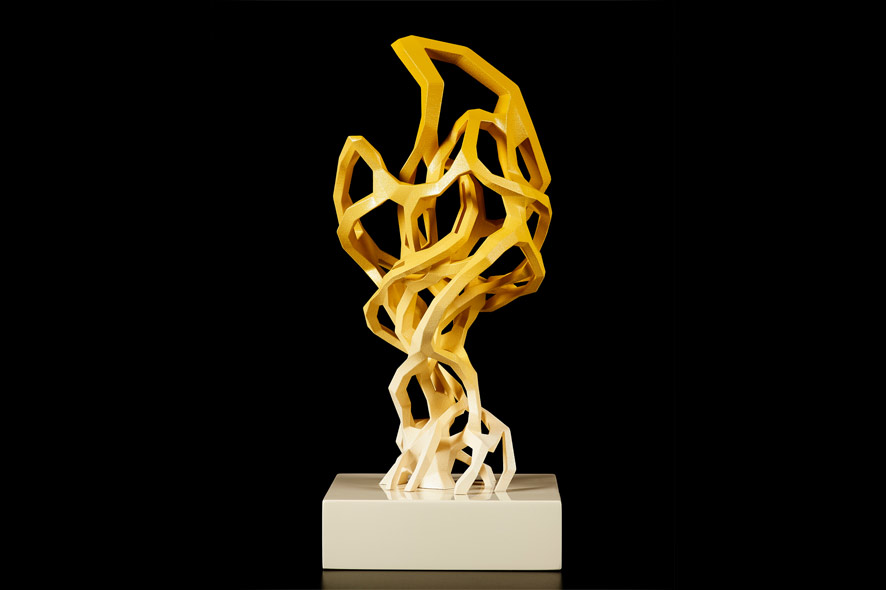STARTS – Science, Technology, Arts. This is the second consecutive year that Ars Electronica—in cooperation with BOZAR and the Waag Society —is calling for entries to a competition to determine this year’s recipients of two STARTS Prizes awarded by the European Commission. Innovative projects at the nexus of science, technology and art can be submitted until March 13, 2017. Each prizewinner in the competition’s two categories receives a €20,000 grant, and his/her project will be prominently featured at, among other venues, the Ars Electronica Festival, BOZAR in Brussels and the Waag Society in Amsterdam. In conjunction with the commencement of the open call, we interviewed Ars Electronica Artistic Director Gerfried Stocker and Veronika Liebl, project manager of the STARTS Prize.
STARTS stands for science, technology and art. In what ways do these three areas overlap in 2017?
Gerfried Stocker: What’s become clearly evident is that this form of collaboration—of bringing to bear artistic and scientific work, and its technical implementation—has substantially gained importance, attention and visibility in recent years. And once again in 2017, in the second year of the STARTS Prize, we want to especially emphasize the significance of this cooperation and ultimately, with this competition, show that an enormous number of initiatives, activities and projects are already underway in this area.
“The purpose of the STARTS Prize is to spotlight these efforts and demonstrate that this isn’t just a bunch of trendy hype; rather, that these really are very substantial contributions to blazing new trails and nurturing innovative developments. Especially for us at Ars Electronica, it’s incredibly exciting to be able to stage this prize competition on behalf of the European Commission. Time and time again, a competition like this, such a worldwide call for entries, brings to light projects that are new and surprising even for us!”
Something that applies equally to all three fields—science, technology and art—is the fact that, despite it all, they know far too little about each other, and that new territories are constantly emerging at the interstices where these areas adjoin. Last year, what really surprised me and many other people with whom I talked about this was the intensity and complexity of the joint undertakings on which artists, scientists and engineers are already cooperating.

Iris Van Herpen and her team received the 2016 STARTS Prize for “Magnetic Motion”. Credit: Morgan O’Donovan
Can it be said that new technologies have to be developed differently today than was the case a few years ago?
Gerfried Stocker: Due to the nature of these new technologies, which are very communicative and oriented on the exchange of social situations, they’re much more present in our everyday life. In technological development up to now, the emphasis has mostly been on just making the product look good, that what takes shape is a good image that can be marketed effectively—that was it, ultimately.
It’s a completely new challenge today—as odd as this may sound to many of us—that people have to be able to get along with their products and technologies, in the sense of coexisting with them. It’s no longer just a matter of the process of convincing customers to decide to purchase the product, and then they use it, and that’s it.
This applies to all sectors such as self-driving cars, smart technologies and smart cities at the core of which are adaptive systems capable of learning, assistive technologies, social robotics—thus, all of these hot topics and keywords that are synonymous with the economic opportunities of the future. All of these areas are interlinked at such a new intensity and form that human beings have to be seen as active participants in this system. At this point, it actually doesn’t matter which technological field or economic sector we consider, since this question of how we’re to reconfigure the relationship between technology and humankind is of decisive relevance everywhere.
“This is not solely of social/ethical/moral relevance, as could have been argued 10 years ago; in the meantime, this has assumed concrete economic relevance. The only developments that will be economically successful over the long term are those that take this factor into account appropriately.”
And this is precisely what makes us cognizant that the professional quality of artists and their dealings with people’s relations to their world and their environment have assumed tremendous importance. It’s so fascinating to see how art is suddenly present in a sphere beyond its own conventional realm and has acquired great significance, importance and influence.

In April 2017 an international jury will meet here in Linz to select the winners of the 2017 STARTS Prize. Credit: Florian Voggeneder
Once again this year, a multinational jury will pick the winners in both STARTS categories. Could you go into some detail about the respective categories?
Veronika Liebl: The Innovative Collaboration category singles out for recognition outstanding examples of cooperation or creative partnerships that lead to innovation. Here, we’re looking for cooperation between R&D facilities or firms on one hand, and art and creativity on the other. Last year’s prizewinner was the Artificial Skins and Bones group, a collaborative effort of Fab Lab Berlin, Weißensee Academy of Art Berlin and a manufacturing firm, Ottobock. This group showed examples of how prostheses can be made user-friendlier and designed in a more innovative way via analysis of various bodily functions and cooperation among all stakeholders. In the Artistic Exploration category, we honor best-practice examples of artistic research or art & culture projects that innovate in terms of technologies, their applications or how they’re perceived. The 2016 honoree was fashion designer Iris Van Herpen whose studio combines nature and technology in a way that makes possible new production methods, forms, technologies and designs.
The STARTS Prize seeks innovative projects in this substantive domain. How do you define innovation?
Gerfried Stocker: This word has gotten so much attention of late because this isn’t a matter of imagining the totally new killer idea in some field. The term innovation also shouldn’t be taken to mean that we’re just looking to present the next big thing, which we’ll then be able to feature as a major attraction. In fact, innovation is, to a much greater extent, response to the great challenge of finally doing something sensible with this huge repertoire of possibilities that digital technology has placed at our disposal over the last 10-20 years. And that calls for blazing new trails, discovering new approaches, and rethinking things.
Veronika Liebl: And it also means that technologies or skills that are already available in creative fields or that artists and creatives are already using can also be applied in other sectors or disciplines. Thus, as we see it, inherent in STARTS is the potential to transfer existing applications to industrial uses, R&D fields and other sectors of the economy. So the STARTS Prize is meant to call attention to precisely this potential—the capacity of artists and creatives to transcend their usual patterns of thought. We aim to enable them to introduce completely new aspects into their work and to navigate new routes to arrive at innovation. In this respect in 2016, we encountered numerous cases which confirm that there’s a diverse array of fields that are already taking advantage of the potential that’s present in the art world and the creative economy—obvious instances, such as design, architecture and fashion, but also counterintuitive examples in medicine, biology, astrophysics, aerospace technology, the software industry, et al.

Artificial Skins and Bones at the STARTS Prize exhibition of the Ars Electronica Festival. Credit: Florian Voggeneder
Who makes up the STARTS Prize’s target audience? If we aim to broaden the focus on artists and scientists, then does this mean that the STARTS Prize’s open call is directed at everyone?
Gerfried Stocker: The STARTS Prize endeavors to attract entries from all those who are actively involved in such cooperative endeavors and transdisciplinary activities. Within the purview of this criterion, it’s completely open as to which role a particular person or group plays. Beginning with the artists, tech-heads, scientists and entrepreneurs who submit their projects for STARTS Prize consideration: it doesn’t matter who the frontman is; the important thing is that this is a project in which such cooperation is successfully taking place. Accordingly, it can’t be said that the STARTS Prize exclusively targets either artists or scientists.
But let there be no misunderstanding—we’re not saying that the only acceptable entrants are those who personally unify these very different worlds. After all, this approach is highly team-oriented, and this was manifested quite clearly in last year’s results. Almost all of the entrants who were short-listed and then ultimately selected by the jury were large teams or collectives. And it’s irrelevant which member of this collective took the initiative and entered.
Veronika Liebl: By the way, the entry deadline is March 13, 2017 and there’s no entry fee. Submissions are welcome from individuals, teams, companies or organizations from throughout the world. Nominations can also be made via Twitter—with the hashtag #startsprize or by mentioning @startsprize in the tweet. Complete details are online at https://starts-prize.aec.at!

At the Ars Electronica Gala in September the winners receive their trophies. In Picture: The artist Iris Van Herpen and the Austrian Federal Chancellor Christian Kern. Credit: Florian Voggeneder
What can the prizewinners look forward to receiving?
Veronika Liebl: The prizewinner in each category receives €20,000 in cash, and the winner will be prominently showcased at the Ars Electronica Festival here in Linz, as well as at the facilities of both of our partners. BOZAR was also involved in 2016; our new associate this year is the Waag Society in Amsterdam. The European Commission has assigned these three organizations the task of conducting the prize competition and presenting the prizewinners throughout Europe in the form of exhibitions, an awards ceremony and artists’ talks. (Incidentally, the STARTS Prize initiative has already been extended until 2020.)
Gerfried Stocker: There was also a series of international presentations—in Tokyo, for example—last year, and this will be carried on in 2017. So, besides the prize money, an added incentive is international publicity reaching far beyond the confines of the European continent.
Comprehensive information about participation and submissions for 2017 STARTS Prize consideration is online at https://starts-prize.aec.at. The entry deadline is March 13, 2017. If you have any questions about the competition, simply send an e-mail to starts-prize@aec.at!
This project has received funding from the European Union’s Horizon 2020 research and innovation programme under grant agreement No 732019. This publication (communication) reflects the views only of the author, and the European Commission cannot be held responsible for any use which may be made of the information contained therein.

